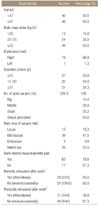Abstract
Purpose
To investigate the prevalence and risk factors of musculoskeletal disorder (MSD) among spine surgeons.
Materials and Methods
A modified version of discomfort survey was sent via e-mail to surgeons that belong to the Korean Society of Spine Surgery. The survey questionnaires were composed of demographics, factors relating to spine surgery, and MSD. We investigated the common sites of occurrence of MSD and its risk factors.
Results
The survey was sent to a total of 420 subjects; of which, 80 subjects (19.0%) responded. About 78.8% of the respondents had MSD for the past year. The common sites of occurrence included the neck (52.5%), back (46.3%), and shoulder (18.8%). The prevalence of pain in the elbow joint/forearm was higher in the group performing a higher frequency of spine surgeries (p=0.033). Moreover, the prevalence of pain in the wrist/hand (p=0.008) and in the back (p=0.042) was higher in those with greater frequency of major surgeries (>10 case/year) as compared with those with lower frequency of major surgeries.
Figures and Tables
References
1. Park JK, Kim DS, Seo KB. Musculoskeletal disorder symptom features and control strategies in hospital workers. J Ergon Soc Korea. 2008; 27:81–92.
2. Ridtitid W, Coté GA, Leung W, et al. Prevalence and risk factors for musculoskeletal injuries related to endoscopy. Gastrointest Endosc. 2015; 81:294–302.e4.

3. Roquelaure Y, Ha C, Leclerc A, et al. Epidemiologic surveillance of upper-extremity musculoskeletal disorders in the working population. Arthritis Rheum. 2006; 55:765–778.

4. Auerbach JD, Weidner ZD, Milby AH, Diab M, Lonner BS. Musculoskeletal disorders among spine surgeons: results of a survey of the scoliosis research society membership. Spine (Phila Pa 1976). 2011; 36:E1715–E1721.
5. Wolf JS Jr, Marcovich R, Gill IS, et al. Survey of neuromuscular injuries to the patient and surgeon during urologic laparoscopic surgery. Urology. 2000; 55:831–836.

6. Alexopoulos EC, Stathi IC, Charizani F. Prevalence of musculoskeletal disorders in dentists. BMC Musculoskelet Disord. 2004; 5:16.

7. Industrial Accident Prevention Association (IAPA). Discomport survey [Internet]. Mississauga (ON): Workplace Safety & Preventation Services (WSPS);2007. Feb. updated 2007 Feb. cited 2015 Dec 1. Available from:www.iapa.ca/pdf/fd_discomfort_survey.pdf.
8. Bovim G, Schrader H, Sand T. Neck pain in the general population. Spine (Phila Pa 1976). 1994; 19:1307–1309.

9. Salemi G, Savettieri G, Meneghini F, et al. Prevalence of cervical spondylotic radiculopathy: a door-to-door survey in a Sicilian municipality. Acta Neurol Scand. 1996; 93:184–188.

10. Pribicevic M. The epidemiology of shoulder pain: a narrative review of the literature. In : Ghosh S, editor. Pain in perspective. Rijeka: INTECH;2012. p. 147–186.
11. Walker-Bone K, Palmer KT, Reading I, Coggon D, Cooper C. Prevalence and impact of musculoskeletal disorders of the upper limb in the general population. Arthritis Rheum. 2004; 51:642–651.

12. United States Bureau of Labor Statistics. Occupational injuries and illnesses in the United States by industry, 1991. Washington, DC: US Government Printing Office;1993.
13. Konstantinou K, Dunn KM. Sciatica: review of epidemiological studies and prevalence estimates. Spine (Phila Pa 1976). 2008; 33:2464–2472.
14. Younes M, Béjia I, Aguir Z, et al. Prevalence and risk factors of disk-related sciatica in an urban population in Tunisia. Joint Bone Spine. 2006; 73:538–542.
15. Feng B, Liang Q, Wang Y, Andersen LL, Szeto G. Prevalence of work-related musculoskeletal symptoms of the neck and upper extremity among dentists in China. BMJ Open. 2014; 4:e006451.

16. Seo SR, Kee DH. Survey of musculoskeletal disorders among nurses in a general hospital. J Ergon Soc Korea. 2005; 24:17–24.
17. Dhimitri KC, McGwin G Jr, McNeal SF, et al. Symptoms of musculoskeletal disorders in ophthalmologists. Am J Ophthalmol. 2005; 139:179–181.

18. Wauben LS, van Veelen MA, Gossot D, Goossens RH. Application of ergonomic guidelines during minimally invasive surgery: a questionnaire survey of 284 surgeons. Surg Endosc. 2006; 20:1268–1274.

19. Szeto GP, Ho P, Ting AC, Poon JT, Cheng SW, Tsang RC. Work-related musculoskeletal symptoms in surgeons. J Occup Rehabil. 2009; 19:175–184.

20. Hansraj KK. Assessment of stresses in the cervical spine caused by posture and position of the head. Surg Technol Int. 2014; 25:277–279.
21. Lim SH, Lee SJ, Kwon YJ, Kim YK, Lee YG, Yoon GW. Study for work relationship of musculoskeletal physical loading work. Seoul: Wonjin Labor Environmental Health Institute;2008. p. 1–7.
22. Park HJ, Sohng KY, Kim S. Validation of the Korean version of the 39-Item Parkinson's Disease Questionnaire (PDQ-39). Asian Nurs Res (Korean Soc Nurs Sci). 2014; 8:67–74.

23. van Det MJ, Meijerink WJ, Hoff C, van Veelen MA, Pierie JP. Ergonomic assessment of neck posture in the minimally invasive surgery suite during laparoscopic cholecystectomy. Surg Endosc. 2008; 22:2421–2427.

24. Park JY, Kim KH, Kuh SU, Chin DK, Kim KS, Cho YE. Spine surgeon's kinematics during discectomy according to operating table height and the methods to visualize the surgical field. Eur Spine J. 2012; 21:2704–2712.

25. Guo HR, Tanaka S, Cameron LL, et al. Back pain among workers in the United States: national estimates and workers at high risk. Am J Ind Med. 1995; 28:591–602.

26. Albayrak A, van Veelen MA, Prins JF, Snijders CJ, de Ridder H, Kazemier G. A newly designed ergonomic body support for surgeons. Surg Endosc. 2007; 21:1835–1840.

27. Shimizu S, Kondo K, Yamazaki T, et al. Hanging foot switch for bipolar forceps: a device for surgeons operating in the standing position: technical note. Neurol Med Chir (Tokyo). 2013; 53:53–55.
28. Andersen LL, Christensen KB, Holtermann A, et al. Effect of physical exercise interventions on musculoskeletal pain in all body regions among office workers: a one-year randomized controlled trial. Man Ther. 2010; 15:100–104.





 PDF
PDF ePub
ePub Citation
Citation Print
Print







 XML Download
XML Download